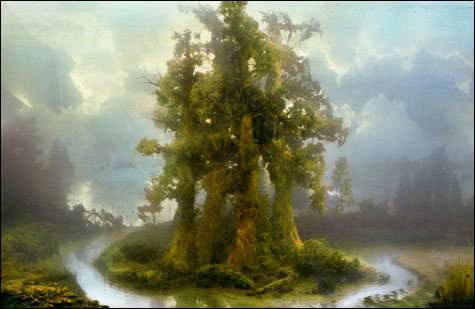
REAL ARTIFICIALITY "Forest 70b," C-print by Kim Keever, 2007. |
| "Twilight" | works by Jim Campbell + Megan Greene + Kim Keever + Bennett Morris | through March 8 | at the ICA at MECA, 522 Congress St, Portland | Gallery talk with Joost During January 29 at noon | 207.879.5742 |
In "Twilight," now showing at the Institute of Contemporary Art at Maine College of Art, four artists pull some roots from the Gothic Romantic tradition and rearrange them to fit their needs. The Romantics sought transcendent human meaning in the midst of a chaotic and fearful universe, a resonant idea in today's world. Different times call for different means, and each of the four artists have brought that Romantic sense of a disturbing, unknowable presence into a contemporary context.Jim Campbell has occupied ICA's large back room with a darkened elegiac installation that is a fictional account of the last day in his brother's life, rendered in a subtle manner that works directly on the viewer's experience. There are 25 lights suspended from the ceiling, each connecting to an electronic module that is hung at about eye level, and each casting a spot on the gallery's darkened floor. The modules are small, dark rectangular objects with an illuminated word or short phrase on them. The light connected to the module changes in way that relates to the text.
Each module becomes a station in the viewer's progress through the room, with the changes in the lights augmenting the idea fragments presented by the words. The stations are a poetic reconstruction of the minute details that are the stuff of a difficult memory.
Kim Keever makes large C-prints by photographing model landscapes he has very carefully constructed in an aquarium filled with water. The result is something that looks like a Luminist or Hudson River School painting gone horribly wrong, as if Albert Bierstadt had been suddenly rendered quite mad.
Bierstadt himself rearranged colors and topographies to suit his purposes, attempting to create a spiritual resonance that suited the ideas of his time. He was documenting the immanence he believed to be inherent in the landscape, as he had learned to do from the work of Kaspar David Friedrich. Keever has taken their artifice a step farther by making images that are manifestly artificial but seem based in an unusual reality. Friedrich and Bierstadt pretended their landscapes were real. Keever does not, and therein lies his essential modernity.
Megan Greene makes intricately drawn arabesques on black paper that are assembled from spare parts. These elegant pictures bring together gears, medals, feathers, crab legs, and other objects collected into graceful, sophisticated forms that rest gently on the rich black background. The mismatched bits and parts look as though they belong together, and in this context, they do.
Each of the parts has its individual emotional resonance created by its apparent history, and by putting them together, Greene bonds them into a unified concoction, like disparate chemical elements with appropriate valences bonded to create a highly charged compound. The drawings are curious, intricate, accomplished, and possessed of a seductive beauty that is tinged with potential menace. Everything is as it should be, except that somewhere something might be going horribly wrong.
Bennett Morris's piece centers around a model of a naval vessel caught in a field of ice. The ship is being broken by the natural forces, and things are going badly for its imaginary inhabitants. The metaphor is direct — technological and natural forces in collision.
Morris mediates his trope through a couple of processes. He has embedded two small video cameras in the model, creating images on two nearby monitors. The effect highlights the counterfeit nature of video.
The other is process is the centuries-old art of silhouette. The rigging of the ship and the broken ice, seen in profile, create an irregular pattern which he shows as a big cutout and in a series of popup books. The pleasant, abstract forms take a while to relate to the unpleasant fictional destruction of the model.
Taken in total, this is an interesting, accomplished, and occasionally surprising exhibition.
Ken Greenleaf can be reached atken.greenleaf@gmail.com.